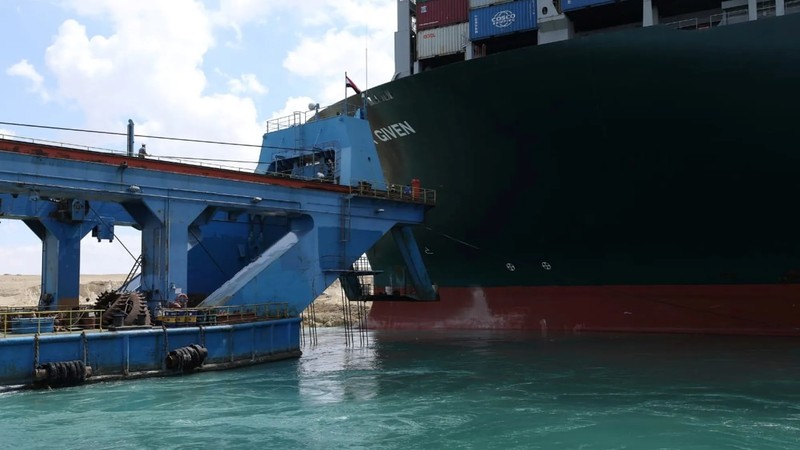Synopsis: The Suez Canal, Egypt’s maritime lifeline accounting for 12% of global trade, faces unprecedented challenges as revenue plunges 50% in early 2024. Houthi attacks in the Red Sea have forced major shipping companies to reroute vessels around Africa, threatening Egypt’s economy and global supply chains. With daily losses of millions in revenue and shipping delays extending up to 10 days, the crisis highlights the fragility of international maritime trade routes.
The Strategic Importance of the Suez Canal
Constructed in 1859-1869, a sea-level waterway connecting Africa and Asia to Europe through the Red Sea, stands the Suez Canal. The Canal provided the shortest international route between Europe and Asia and for this reason, it was incredibly important to the British former colonisers of Egypt. The international route allowed for ease of flow of goods between England and their other former colonies like India and modern-day Pakistan or Bangladesh, for example. The relevancy, symbolism and massive importance this canal has for Egypt’s sovereignty and global trade is almost immeasurable.
The Canal is one of the world’s heavily used shipping lanes, spanning a length of slightly over 193 km (120 miles). The Canal spans between the Port Said in the North towards the Mediterranean Sea and Port Tawfiq near the city of Suez, leading to the Gulf of Suez. It is well understood that water transportation is the cheapest mode of transport and is very suitable for bulky and heavy goods over long distances.
A Hub for Global Maritime Trade
The Suez Canal plays a major role in global trade being one of the busiest maritime trade routes and accounting for 12% of global trade and 30% of all global container traffic. In 2020, around 19 000 ships used the canal, averaging about 50 ships daily and carrying cargo worth between USD 3-9 billion. However, in November 2024, only 115 container vessels passed through the Suez Canal, a 72% decline compared to 442 the year prior rerouting to avoid the Red Sea.
Despite shipping being the most beneficial for freight, there are significant risks attached like delays caused by route blockages. Evidence of this was witnessed in March 2021 when the Ever Given, a 400 metre-long container ship blocked the Canal for six days and held over 100 ships on either side. Thus, highlighting the vulnerability of global supply chains and the critical role the Suez Canal holds to global trade.
Expansion Projects and Challenges
The block did come as a surprise as the infrastructure had undergone expansion projects in recent years (2014). The Egyptian Government oversaw an $8 billion expansion project that widened the Suez from 61 metres to 312 metres for a 21-mile distance meaning that the canal can accommodate ships passing in both directions at the same time.
The Suez Canal is a vital artery for global maritime trade, facilitating the transit of various vessel types like car carrier fleet, tankers or bulk carriers. A paper from the Journal of Shipping and Trade states that in 2022, “about 9.9% of all maritime traffic, 22.6% of all fleets, and 15% of all grains via the canal”. Furthermore, there are estimates that the Canal facilitates the transit of “over 25% of container seaborne trade, approximately one-third of container ship capacity was used on services scheduled to use the Canal, and 45% of container ship tonnage passed through the Canal in 2022.” Moreover, the Canal carries around 7-10% of the world’s oil and 8% of liquified natural gas with approximately one million barrels of oil traversing the Canal daily. Taking all the above into consideration, the consistent flow of goods through the Canal is critical for maritime traffic and must ensure that there is efficient flow of trade flows.
Impact of Red Sea Conflicts on the Canal
The war in Palestine by Israel and in Yemen has caused the Red Sea to be a location of contestation and violence. This has resulted in a 50% drop year-on-year in the first two months of 2024 from the year prior; and due to the potential risk of ships in transit being under attack there has been a reduced traffic in the Suez Canal. The solution thus far is for multiple shipping companies re-routing cargo around the Cape of Good Hope. This remedy has increased delivery time by 10 or more days, and of course reduces the revenue income for the Egyptian economy. Additionally, the ongoing attacks against the Houthi targets in Yemen have escalated tensions in the Red Sea, further deterring shipping companies from using the Canal.
Economic Consequences of Suez Canal Disruptions
Revenue from the Suez Canal, a key source of foreign income for Egypt, has dropped significantly due to regional conflicts disrupting shipping routes. The President reported monthly losses of $800 million, dropping 60.7% with the total earnings falling to $4 billion in 2024 from $10.2 billion in 2023. This decline is largely attributed to Houthi attacks on vessels in protest against Israel’s actions in Gaza.
Looking ahead, the ongoing instability in the Red Sea has led to an estimated $7 billion loss in Suez Canal revenue for 2024, prompting the Egyptian government to continue with modernisation projects to enhance the canal’s competitiveness. With many shipping companies opting for alternative routes, the long-term impact on Egypt’s economy remains uncertain.





